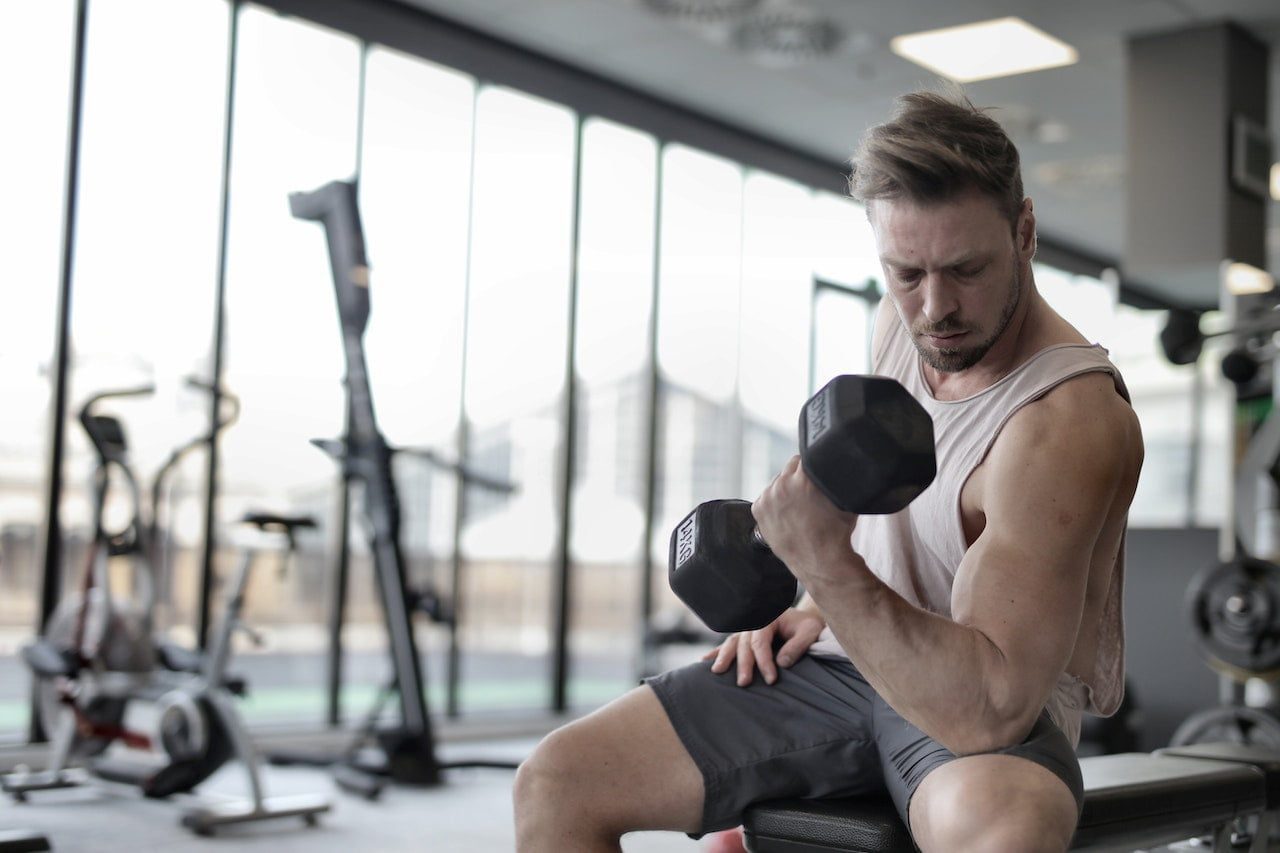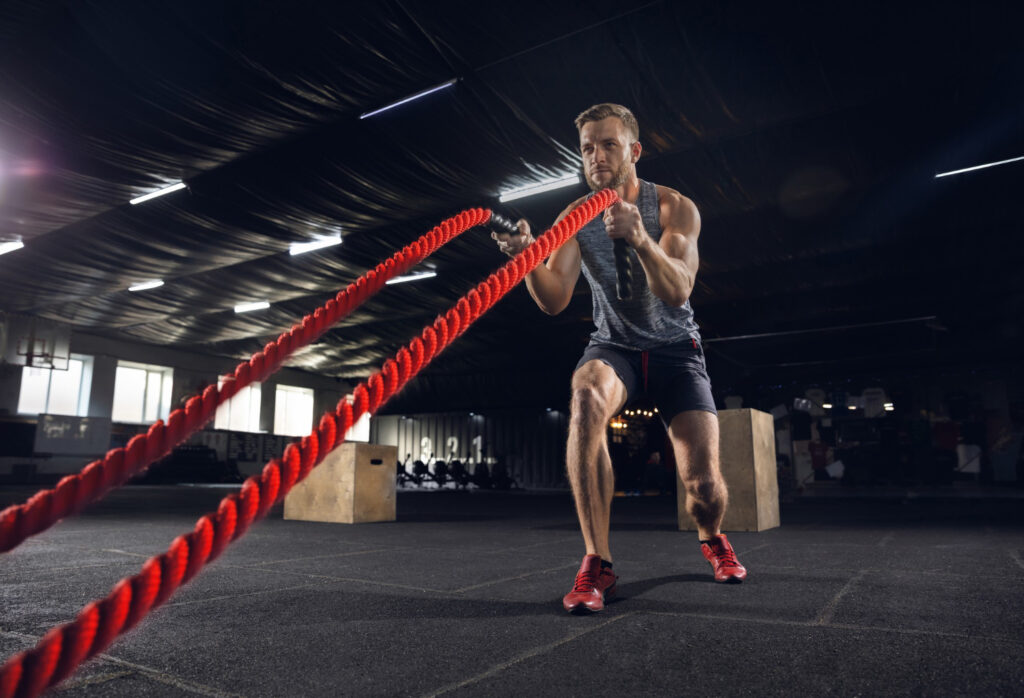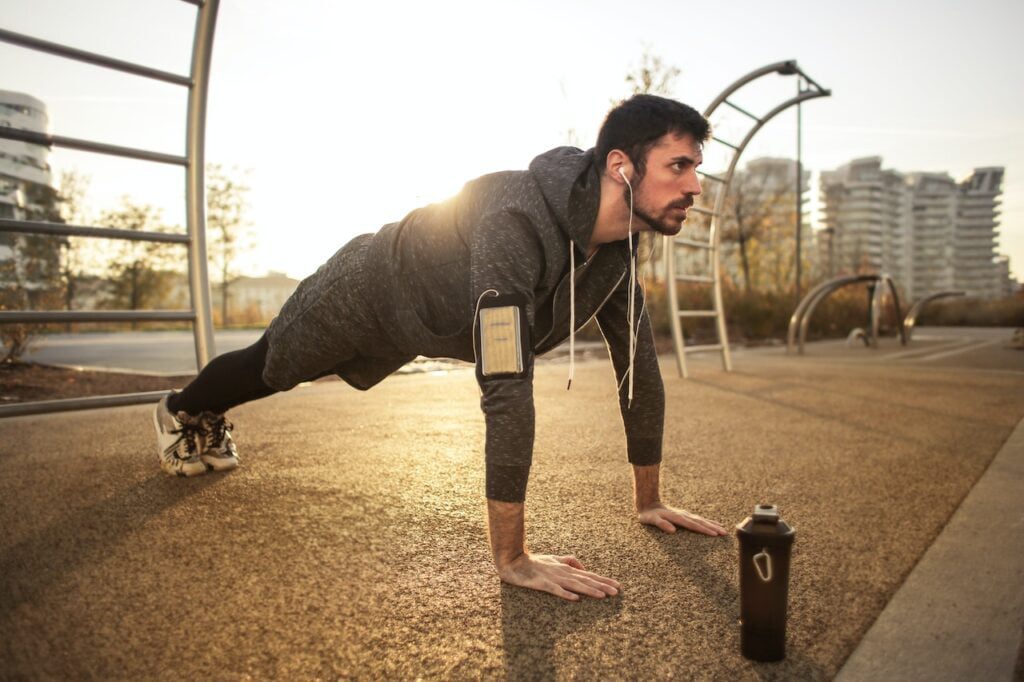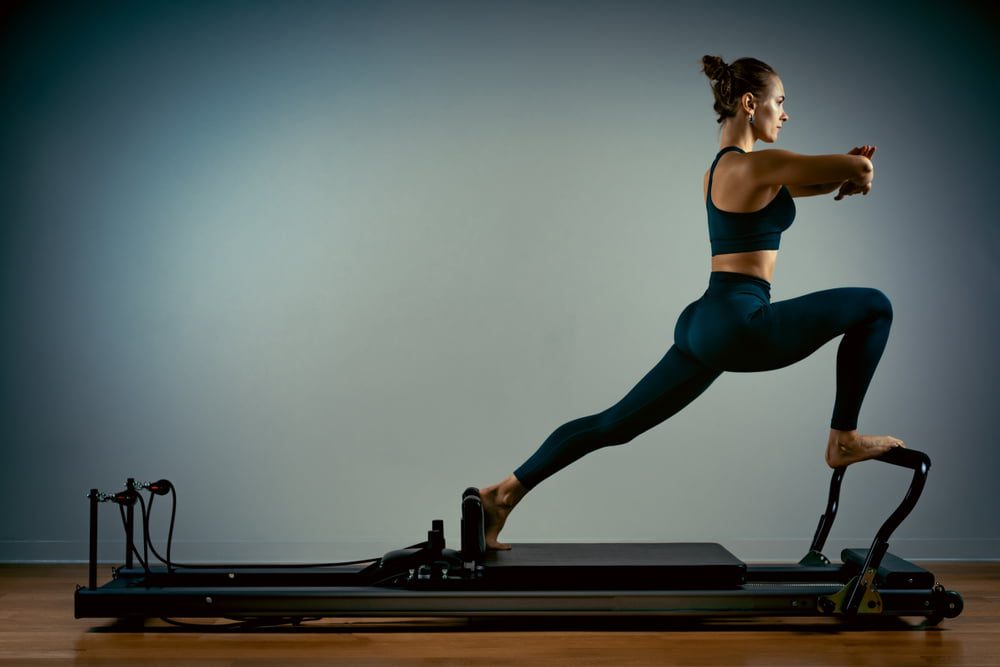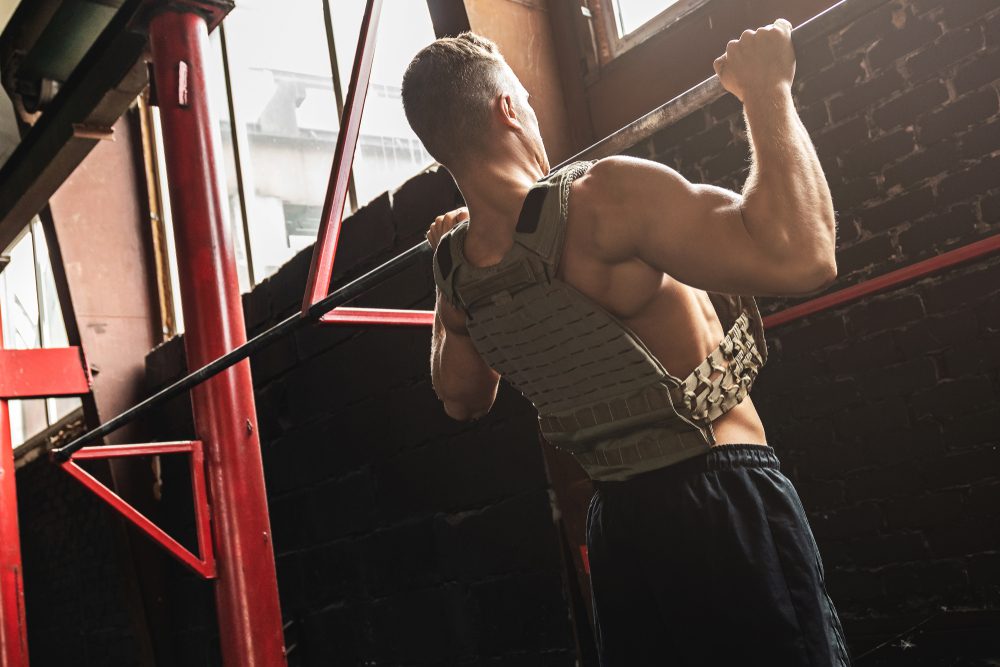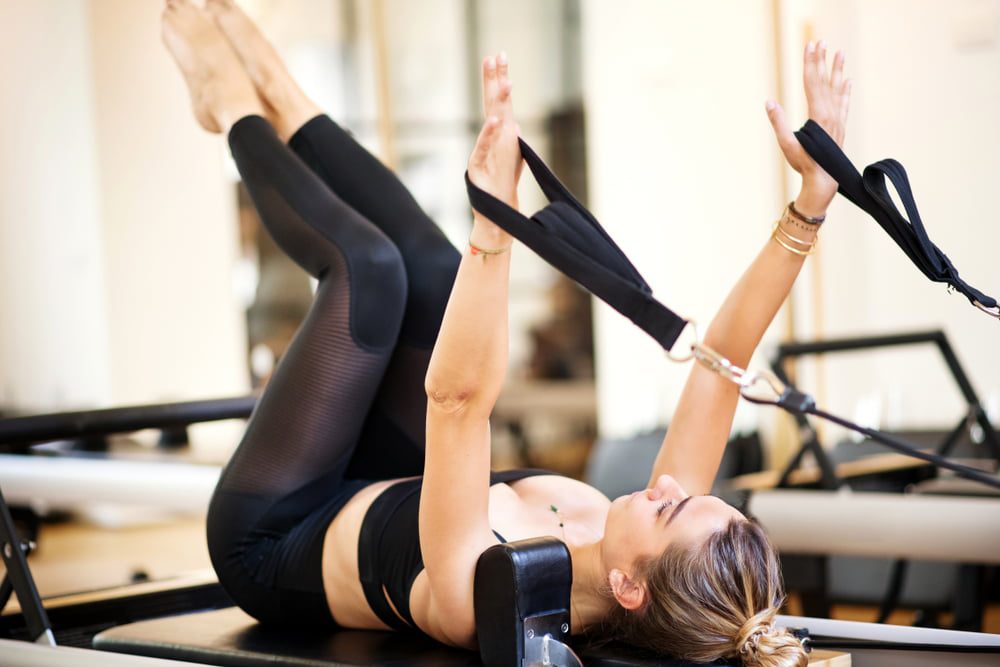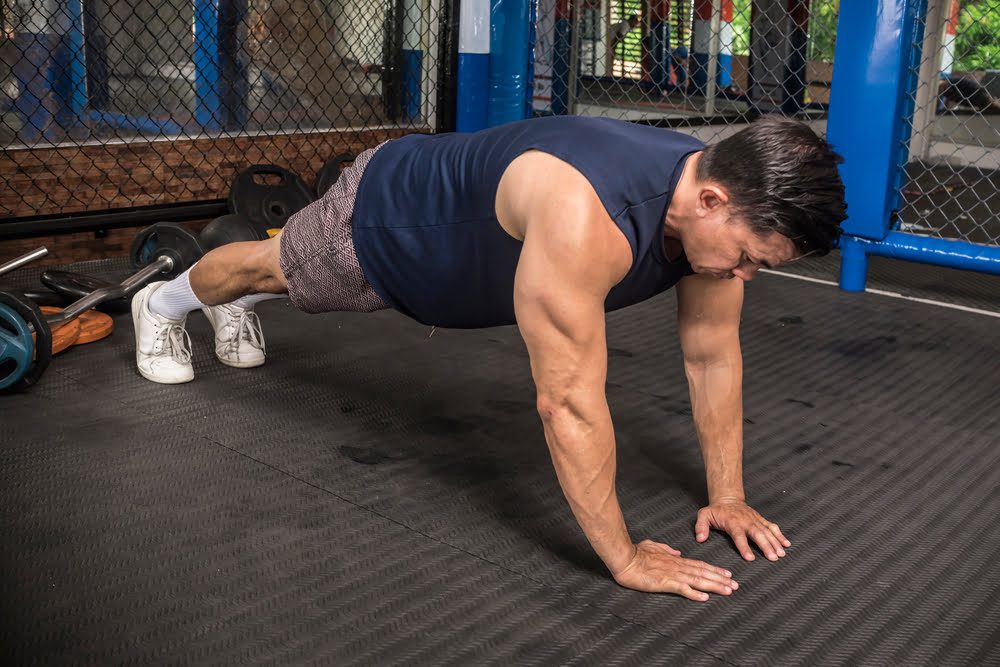In today’s fast paced world, finding time to hit the gym or engage in regular exercise routines can be a challenge. However, staying fit & healthy is essential for our overall wellbeing. Thankfully, there are numerous ways to incorporate exercise into our daily lives, even without fancy equipment or a gym membership. One unconventional yet highly effective method involves utilizing an everyday household item – the brick. Yes, you read that right! Bricks can serve as versatile workout tools, providing resistance and adding an extra level of intensity to your home workouts. In this article, we will explore 10 different home workouts that can be done with a brick, offering a convenient and cost effective solution for those seeking to stay active and fit without leaving the comfort of their own homes. So, grab a brick, prepare to break a sweat & let’s dive into these innovative and accessible fitness routines.
10 Home Workout That Can Be Done with Brick.
1. Brick Squats.
Brick squats are a challenging exercise that target the lower body muscles, particularly the quadriceps, hamstrings & glutes. These are a versatile exercise that can be performed by individuals of all fitness levels, as the weight of the bricks can be adjusted to match one’s strength & capabilities. Incorporating brick squats into a regular workout routine can help to improve leg strength, stability & overall lower body endurance.

How to do Brick Squats?
- Start by standing with your feet shoulder width apart and your toes pointing slightly outward.
- Hold a brick or a dumbbell in both hands, with your arms extended downwards.
- Lower your body into a squat position by bending your knees and pushing your hips back.
- Keep your chest up and your back straight throughout the movement.
- As you squat down, try to bring your thighs parallel to the ground or as low as you can comfortably go.
- Push through your heels and engage your glutes and quadriceps to come back up to the starting position.
- Remember to breathe in as you lower your body and exhale as you come back up.
- Adjust the weight of the brick or dumbbell as needed to challenge yourself but still maintain proper form.
Beginner.
3 sets of 8 reps.
60 seconds rest between each sets.
Intermediate.
4 sets of 10 reps.
45 seconds rest between each sets.
Advanced.
4 sets of 12 reps.
30 seconds rest between sets.
2. Brick Lunges.
Brick lunges refer to a type of exercise that involves performing lunges while holding a brick. This variation of lunges adds an extra challenge and intensity to the traditional lunge exercise, targeting the muscles in the lower body, including the quads, hamstrings, glutes & calves. By adding weight to the movement, brick lunges help to increase strength, stability & balance.
Additionally, the resistance offered by the brick helps to engage the core muscles, further enhancing the overall effectiveness of the exercise. Brick lunges can be a great option for individuals looking to add variety to their workout routine & take their lunge exercise to the next level.
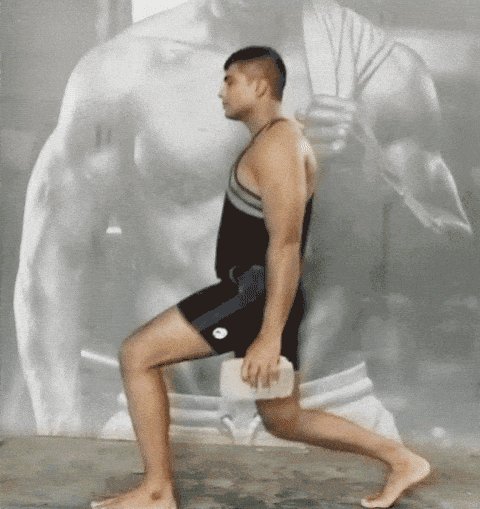
How to do Brick Lunges?
- Start by standing with your feet hip width apart & holding a dumbbell in each hand, palms facing your body.
- Take a step forward with your right foot, landing on the heel & rolling through the foot to the toes.
- As you step forward, bend both knees to lower your body into a lunge position. Your right thigh should be parallel to the floor & your left knee should be hovering just above the ground.
- Keep your upper body upright, engaging your core muscles to maintain stability.
- Push through your right heel to straighten your right leg & return to the starting position.
- Repeat the movement, this time stepping forward with your left foot and performing a lunge with your left leg.
- Continue alternating legs, completing a set number of reps or time.
- Remember to keep your knees aligned with your ankles and avoid letting them collapse inward.
- Breathe steadily throughout the exercise, inhaling as you lower into the lunge & exhaling as you push back up.
- To make the exercise more challenging, you can increase the weight of the dumbbells or incorporate additional resistance such as a barbell or resistance bands.
Beginner.
3 sets of 8 reps.
60 seconds rest between each sets.
Intermediate.
4 sets of 10 reps.
45 seconds rest between each sets.
Advanced.
4 sets of 12 reps.
30 seconds rest between sets.
3. Brick Bicep Curls.
Brick bicep curls are a unique & challenging variation of traditional bicep curls. Instead of using dumbbells or weights, individuals use bricks as their resistance. This exercise requires strength, stability and control as the bricks can be heavy and unstable. Brick bicep curls help to build & strengthen the biceps, forearms & grip strength.
This exercise can be performed at home or in an outdoor setting, making it a versatile option for those looking to incorporate unconventional training methods into their workout routine.
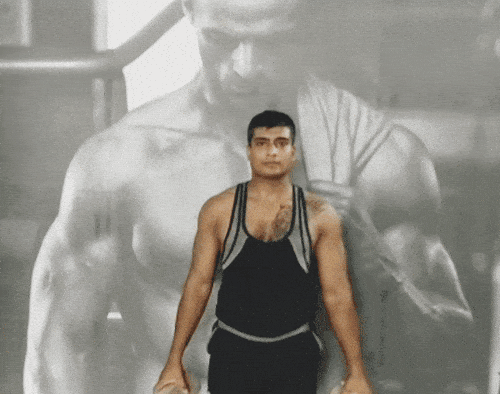
How to do Brick Bicep Curls?
- Start by standing with your feet shoulder width apart and holding a brick in each hand.
- Keep your back straight and your core engaged throughout the exercise.
- Begin the movement by bending your elbows and bringing the bricks up towards your shoulders, while keeping your upper arms stationary.
- Squeeze your biceps at the top of the movement, then slowly lower the bricks back down to the starting position.
- Ensure that you are using controlled & smooth motions throughout the exercise.
- Focus on contracting your biceps & maintaining proper form rather than using heavy weights.
- Modify the exercise by using different brick sizes or adding resistance bands for variation.
Beginner.
3 sets of 10 reps.
60 seconds rest between each sets.
Intermediate.
4 sets of 14 reps.
45 seconds rest between each sets.
Advanced.
4 sets of 18 reps.
30 seconds rest between sets.
4. Brick Triceps Extensions.
Brick triceps extensions are a challenging & effective exercise that targets the triceps muscles in the arms. This exercise involves holding a brick in both hands & extending the arms overhead, fully engaging the triceps muscles. The weight of the brick adds resistance, making this exercise a great way to build strength and definition in the triceps.
Brick triceps extensions can be done standing or seated and can be modified to suit different fitness levels by using different sizes or weights of bricks. Incorporating this exercise into a regular workout routine can help to improve overall arm strength and enhance the appearance of toned and sculpted triceps.

How to do Brick Triceps Extensions?
- Start by standing with your feet shoulder width apart & holding a brick in both hands.
- Extend your arms overhead, keeping your elbows close to your ears & palms facing forward.
- Slowly lower the brick behind your head, bending your elbows & keeping them pointed forward.
- Once your forearms are parallel to the ground, pause for a second & then push the brick back up to the starting position.
- Make sure to engage your triceps throughout the exercise and avoid using your shoulders or back to lift the brick.
- Maintain a controlled pace and focus on proper form to maximize the effectiveness of the exercise.
- If using a heavier brick becomes too challenging, start with a lighter one and gradually increase the weight as you build strength.
Beginner.
3 sets of 10 reps.
60 seconds rest between each sets.
Intermediate.
4 sets of 12 reps.
45 seconds rest between each sets.
Advanced.
4 sets of 14 reps.
30 seconds rest between sets
5. Brick Shoulder Press.
The brick shoulder press is a strength training exercise that primarily targets the shoulders & upper body. It involves lifting two bricks, one in each hand, from shoulder height to an overhead position. This exercise not only strengthens the deltoids but also engages the trapezius, triceps & core muscles.
The use of bricks adds an extra challenge, as they are typically heavier and less balanced than traditional dumbbells or barbells. The brick shoulder press can be modified to suit different fitness levels by adjusting the weight of the bricks or the number of repetitions. Regular practice of this exercise can lead to improved upper body strength, stability & muscular endurance.

How to do Brick Shoulder Press?
- Start by standing with your feet shoulder width apart and holding a brick in each hand at shoulder level, with your palms facing forward.
- Engage your core & keep your back straight throughout the exercise.
- Push the brick upward in a controlled manner, fully extending your arms without locking your elbows.
- As you press the weights overhead, rotate your wrists so that your palms are facing each other at the top of the movement.
- Pause for a moment at the top, then slowly lower the weights back down to shoulder level, while maintaining control and keeping your core engaged.
- To modify the exercise, you can also perform it seated on a bench or stability ball, which may help to stabilize your back & provide additional support.
Beginner.
3 sets of 8 reps.
60 seconds rest between each sets.
Intermediate.
4 sets of 10 reps.
45 seconds rest between each sets.
Advanced.
4 sets of 12 reps.
30 seconds rest between sets.
6. Brick Russian Twists.
Brick Russian Twists are a challenging exercise that targets the abdominal muscles & obliques. This exercise are an effective way to strengthen & tone the core, improve rotational stability and enhance overall athleticism.
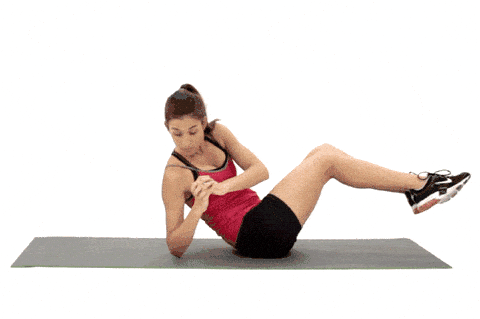
How to do Brick Russian Twists?
- Sit on the ground with your knees bent & your feet flat on the floor.
- Hold a brick or a dumbbell with both hands, keeping your arms extended in front of you.
- Engage your core muscles and lean back slightly, making sure to keep your spine straight.
- Lift your feet off the ground, balancing on your tailbone.
- Slowly twist your torso to the right, bringing the brick or dumbbell towards the right side of your body.
- Return to the center and then twist to the left, bringing the brick or dumbbell towards the left side of your body.
- Continue alternating twists from side to side, while keeping your feet off the ground & your core engaged.
- Aim for controlled and smooth movements, rather than speed.
- Remember to breathe throughout the exercise and maintain proper form.
Beginner.
3 sets of 8 reps.
60 seconds rest between each sets.
Intermediate.
4 sets of 10 reps.
45 seconds rest between each sets.
Advanced.
4 sets of 12 reps.
30 seconds rest between sets.
7. Brick Push Ups.
Brick push ups are a challenging variation of traditional push ups that require a higher level of strength and stability. This exercise targets the chest, shoulders, triceps & core muscles, providing a full upper body workout.
The use of bricks increases the difficulty by forcing you to engage your stabilizer muscles & maintain balance throughout the movement. Brick push ups are a great way to progress your push up routine & add variety to your workout, helping you to build strength & improve your overall fitness level.
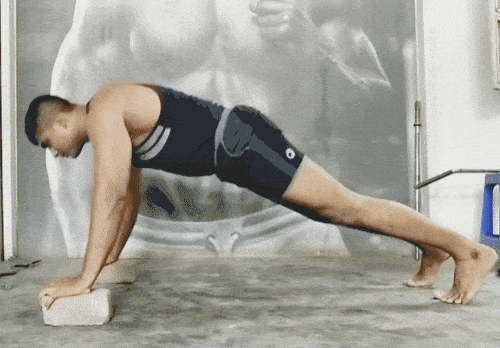
How to do Brick Push Ups?
- Begin by placing your hands shoulder width apart on a sturdy surface, like a brick or elevated surface.
- Position yourself in a push up position, with your body in a straight line from head to toe.
- Lower your chest towards the brick by bending your elbows, keeping them close to your body.
- Push back up to the starting position by straightening your arms.
- Focus on engaging your core & maintaining proper form throughout the exercise.
- Modify the exercise by adjusting the height of the brick or surface to increase or decrease the intensity.
- Gradually increase the number of repetitions or sets as you build strength and proficiency in the exercise.
Beginner.
3 sets of 8 reps.
60 seconds rest between each sets.
Intermediate.
4 sets of 10 reps.
45 seconds rest between each sets.
Advanced.
4 sets of 12 reps.
30 seconds rest between sets.
8. Brick Plank Rows.
Brick plank rows are a type of exercise that targets the muscles in the back, shoulders and arms. This exercise not only strengthens the upper body muscles but also improves stability, balance & overall posture.
Brick plank rows can be modified by adjusting the weight of the bricks or adding variations such as alternating arms or incorporating a leg lift. Overall, brick plank rows are an effective and challenging exercise that provides a full body workout.
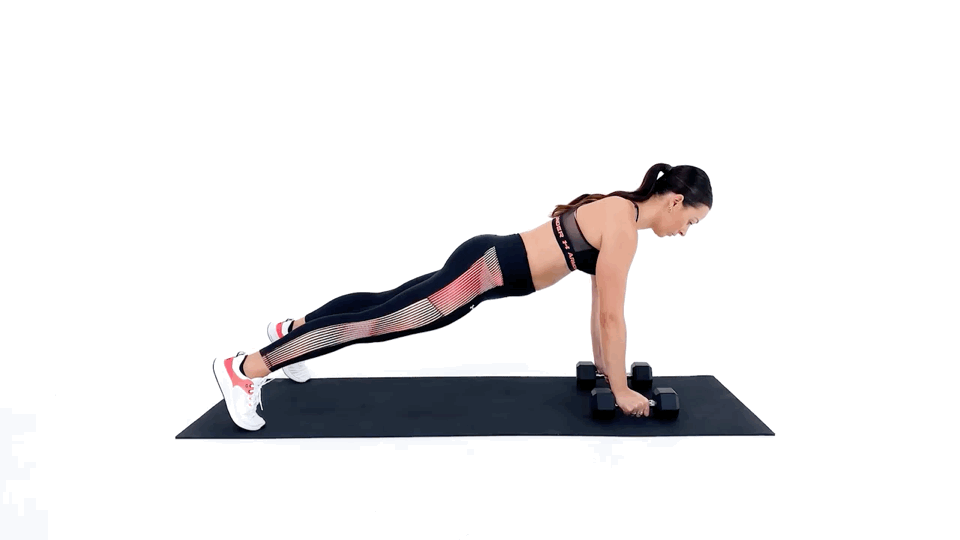
How to do Brick Plank Rows?
- Start by placing two brick planks parallel to each other on the ground, with enough space between them for your body to fit in.
- Position yourself in a plank position, with your hands gripping the brick planks and your body in a straight line from head to toe.
- Engage your core and keep your back flat throughout the exercise.
- Begin the movement by pulling one elbow back, keeping it close to your body, until your hand reaches your ribcage.
- Lower your arm back down slowly and repeat the same movement with the other arm.
- Continue alternating between arms, focusing on squeezing your shoulder blades together with each row.
- Aim for a controlled and smooth motion, avoiding any swinging or jerking movements.
- Perform the desired number of repetitions, typically 8 to 12 per arm or as recommended by your fitness instructor or trainer.
- Remember to breathe steadily throughout the exercise and maintain proper form to maximize the benefits & minimize the risk of injury.
Beginner.
3 sets of 10 reps.
60 seconds rest between each sets.
Intermediate.
4 sets of 12 reps.
45 seconds rest between each sets.
Advanced.
4 sets of 14 reps.
30 seconds rest between sets.
9. Brick Step Ups.
Brick step ups are a popular exercise used to strengthen and tone the lower body muscles, particularly the glutes, quadriceps and calves. This exercise can be modified to suit different fitness levels by adjusting the height of the platform or adding weights.
This exercise not only improves lower body strength but also enhances balance, stability, and coordination. It can be easily incorporated into a workout routine and offers a challenging yet effective way to target the leg muscles.
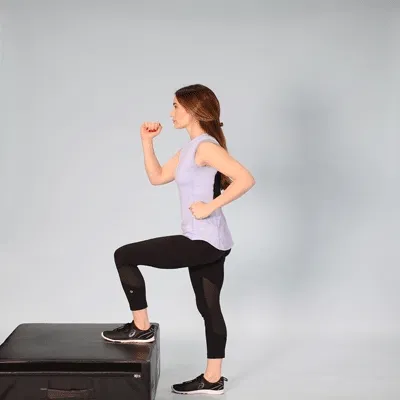
How to do Brick Step Ups?
- Find a sturdy brick or step to use for the exercise.
- Stand facing the brick with your feet shoulder width apart.
- Place your right foot firmly on top of the brick, ensuring your entire foot is on the surface.
- Push through your right heel to lift your body up onto the brick, transferring your weight onto your right leg.
- Keep your core engaged and back straight throughout the movement.
- Slowly lower your left foot back down to the ground, maintaining control & balance.
- Switch sides & perform the same steps with your left foot on the brick.
- To increase the intensity, you can hold dumbbells in each hand or add a knee raise at the top of the step up.
- Remember to always start with a warm-up and consult with a fitness professional if you have any concerns or limitations.
Beginner.
3 sets of 8 reps.
60 seconds rest between each sets.
Intermediate.
4 sets of 10 reps.
45 seconds rest between each sets.
Advanced.
4 sets of 12 reps.
30 seconds rest between sets.
10. Brick Overhead Walking Lunges.
Brick overhead walking lunges are a challenging exercise that targets multiple muscle groups, particularly the lower body and core. The brick adds an element of instability, requiring core activation to maintain balance and control throughout the movement.
Overall, brick overhead walking lunges are an effective exercise for building strength, stability, and muscular endurance in the entire body.
How to do Brick Overhead Walking Lunges?
- Start by holding a brick in each hand, with your arms extended down by your sides.
- Stand tall with your feet hip width apart.
- Take a step forward with your right foot, ensuring that your knee is directly above your ankle.
- As you step forward, lift your left foot off the ground & bring it up towards your chest.
- While keeping your core engaged and maintaining an upright posture, lower your body down into a lunge position until your back knee is almost touching the ground.
- Push through your right foot to bring your left foot back down to the ground and step forward into the next lunge.
- Continue alternating legs as you walk forward, ensuring that your knee is directly above your ankle with each lunge.
- Keep your chest lifted and your shoulders relaxed throughout the exercise.
- To increase the intensity, you can increase the weight of the bricks or increase the number of lunges.
Beginner.
3 sets of 8 reps.
60 seconds rest between each sets.
Intermediate.
4 sets of 10 reps.
45 seconds rest between each sets.
Advanced.
4 sets of 12 reps.
30 seconds rest between sets
Benefits of Home Brick Workout.
There are numerous benefits of incorporating a home brick workout into your fitness routine. Whether you are an experienced athlete or just starting your fitness journey, this type of workout can offer significant advantages.
1. Convenience.
One of the most appealing aspects of a home brick workout is the convenience it provides. You don’t have to worry about commuting to a gym or adhering to specific class schedules. Instead, you can complete your workout anytime, right in the comfort of your own home. This not only saves you time but also allows you to fit exercise into your busy schedule more easily.
2. Cost effective.
Investing in home workout equipment, such as dumbbells, resistance bands, or a stationary bike, can be more cost-effective in the long run compared to a gym membership. Additionally, you can gradually build your collection of equipment over time, tailoring it to your specific fitness goals and preferences. This financial flexibility can be a significant advantage for many individuals.
3. Privacy.
Some people feel self-conscious when working out in public spaces. With a home brick workout, you have complete privacy. This allows you to focus solely on your workout without any distractions or concerns about others watching you. It can create a more comfortable and relaxed environment, enhancing your overall exercise experience.
4. Customization.
Another benefit of a home brick workout is the ability to customize it to your specific needs and preferences. You have the freedom to choose which exercises, sets, and repetitions you want to incorporate into your routine. This level of customization ensures that you are targeting the areas you want to work on and can adapt your workout as your fitness level progresses.
5. Time efficiency.
A home brick workout enables you to combine different exercises into one efficient session, maximizing your time. For example, you can alternate between strength training exercises and cardiovascular activities like running on a treadmill or cycling on a stationary bike. This combination helps improve your overall fitness and saves time by eliminating the need for separate workouts.
6. Adaptability.
Home brick workouts are incredibly adaptable, allowing you to modify the intensity and difficulty level as needed. Whether you are a beginner or an advanced athlete, you can tailor your workout to meet your current fitness level and gradually increase the challenge over time. This adaptability ensures that you continue to progress and avoid hitting plateaus in your fitness journey.
7. Consistency.
Having a home brick workout routine promotes consistency in your exercise habits. Since you have the convenience and flexibility to work out at any time, it becomes easier to stick to a regular schedule. Consistency is key to achieving and maintaining your fitness goals, and a home brick workout helps you establish a routine that works for you.
Footnote. Home brick workout offers numerous benefits, including convenience, cost-effectiveness, privacy, customization, time efficiency, adaptability, and consistency. By incorporating this type of workout into your fitness routine, you can achieve your goals and maintain a healthy lifestyle from the comfort of your own home.
Frequently asked questions.
Bottom Line.
The home brick workout offers a convenient & effective way to improve fitness and strength without the need for expensive gym memberships or specialized equipment. It combines the benefits of both cardiovascular and strength training, making it a well rounded workout option. The versatility of bricks allows for endless variations & modifications to suit individual needs and fitness levels. Additionally, the home brick workout can be easily incorporated into daily routines, making it accessible to individuals with busy schedules. Whether you are a beginner or an experienced athlete, the home brick workout provides a challenging & rewarding fitness regimen that can be done from the comfort of your own home. So, grab a couple of bricks and start building a stronger, fitter and healthier you today.
How we reviewed this article:
Our team of experts is always monitoring the health and wellness field, ensuring that our articles are updated promptly as new information emerges. See Our Editorial Process
May 13, 2025
Written By: Uttam
Reviewed By: David Rosales
Written By: Uttam
Reviewed By: David Rosales

 Workout
Workout
 Meditation
Meditation





 Contact Us
Contact Us

